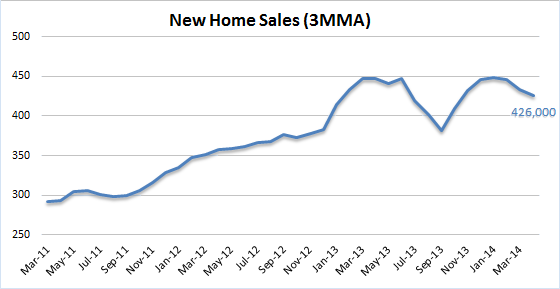Economy

New Residential Sales Bounce Back In April
Written by Sandy Williams
May 27, 2014
New home sales bounced back in April after declining for two straight months. New residential sales reached a seasonally adjusted annual rate of 433,000 in last month, according to data released by the US Census Bureau and Department of Housing and Urban Development. April’s rate increased 6.4 percent following a plummet of 10 percent in March (based on a revised rate 407,000). Sales, however, continue to drag below 2013 levels, posting 4.2 percent below estimates in April last year.
When looking at the data from a three month moving average (3MMA) basis, we found new housing sales trending lower with the 3MMA at 426,000 units, down from 434,000 the prior month and 445,000 units two months prior. As you can see from our graphic, the 3MMA has been trying to break the 450,000 unit level and has been unable to do so.
Prices for new residential sales fell in April. The median sales price in April was $275,800 compared to $290,000 in March and average sale price was $320,100 compared to $334,200 the previous month.
The April inventory of available new homes was 192,000 compared to 193,000 in March, representing a supply of 5.3 months at the current sales rate.
The April sales data was better than economists expected after the recent months of decline but is still not indicative of a meaningful pickup in housing growth. Builder sales are improving up but tight credit and weak income growth is slowing market recovery.
“New home sales bounce back to mediocrity,” is how IHS analysts Stephanie Karol and Patrick Newport described the April sales data in a recent report.
“Builders are gradually increasing sales, but tight credit conditions, particularly for first-time home buyers, are impeding a more robust recovery,” said Kevin Kelly, chairman of the National Association of Home Builders (NAHB) and a home builder and developer from Wilmington, Del.
Fixed 30-year mortgage rates fell to an average of 4.14 percent this week, according to Freddie Mac, which may help out buyers looking to complete sales in June.
“In a positive development, builders are adding inventory in anticipation of a further release of pent-up demand,” said NAHB Chief Economist David Crowe. “We are only about half-way back to what could be considered a normal market, but relatively low mortgage rates and affordable home prices are other factors that should help keep starts and sales on a slow upward trajectory in the months ahead.”
Regionally, new-home sales rose in the Midwest by 47.4 percent in the Midwest and in the South by 3.1 percent. Sales were steady in the West while the Northeast posted a 26.7 percent decline.

Sandy Williams
Read more from Sandy WilliamsLatest in Economy

New York state manufacturing index drops again in April
Firms were pessimistic, with the future general business conditions index falling to its second lowest reading in the more than 20-year history of the survey

Construction adds 13,000 jobs in March
The construction sector added 13,000 jobs, seasonally adjusted, in March, but tariffs could undermine the industry.

Supply chains, end-users brace for impact from tariffs
Supply chains are working through what the tariffs mean for them

ISM: Manufacturing expansion loses steam after two months of growth
US manufacturing activity slowed in March after two straight months of expansion, according to supply executives contributing to the Institute for Supply Management (ISM)’s latest report.

Chicago Business Barometer rose to 16-month high in March
The Chicago Business Barometer increased for the third-consecutive month in March. Despite this, it still reflects contracting business conditions, as it has since December 2023.

